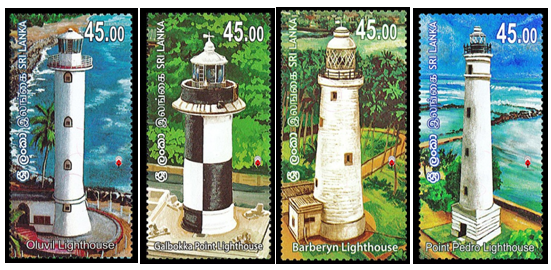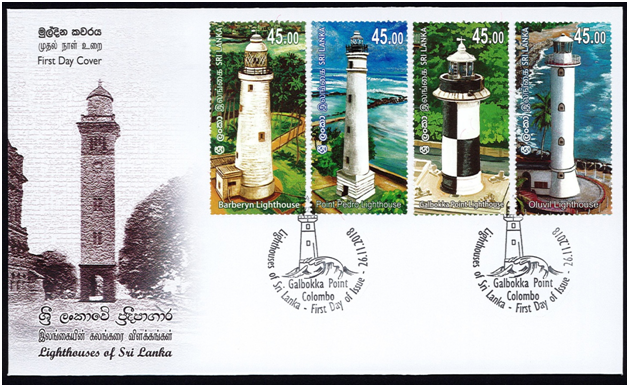

Home/Active Page

Sri Lanka Philatelic Bureau of the Department of Posts has issued four new postage stamps in the denominations of Rs.45.00 each depicting Lighthouses Sri Lanka and four Miniature Sheets in denominations of Rs.45.00 each on 26th November, 2018.
| Date of Issue | 26th November, 2018 |
| Denomination | Rs.45.00 x 4 |
| Catalogue No: | Barberyn Lighthouse - CSL 2305 Point Pedro Lighthouse - CSL 2306 Galbokka Point Lighthouse - CSL 2307 Oluvil Lighthouse - CSL 2308 |
| Stamp Designer | Ruwan Upasena |
| FDC Designer | P. Isuru Chathuranga |
| Stamp Designer | Ruwan Upasena | Stamp Size: | 30mm x 60mm |
| Sheet Composition: | 20 stamps per sheet |

|
|
|
|
"The lighthouse was then a silvery, misty-looking tower with a yellow eye, that opened suddenly and softly in the evening" – Virginia Woolf to the Lighthouse.
Lighthouses are guiding lights that has stood for more than a thousand years. Even as waves batter their sides, lighthouses stand proud and erect, guiding the way for all storm –tossed mariners. They are used to indicate dangerous coastlines, underwater rocks and shoals and to guide ships through the channels safely in and out of harbours. The earliest lighthouses were beacon fires or candles displayed through windows of buildings. With the advancement of technology more advanced methods were used to beam the flash from lighthouses such parabolic reflectors and Fresnel lens invented in the nineteenth century by the French Civil Engineer Augustin – Jean Fresnel. To light the fires during the earliest times various types of oil were used and by the 1900's oil gave away to gas, electricity and more recently to solar power. These man-made wonders, until recently were manned by lighthouse keepers. They underwent tremendous difficulties in performing their duties day and night to ensure the safety of sea going vessels and mariners. They would trim wicks, top up oil, keep the lenses clean, and operate the various mechanisms. The turn of the twentieth century saw most lighthouses being automated. Lighthouses are amazing feats of engineering built on the stormiest coastlines. They have stood for centuries and have saved millions of lives in the era before modern navigation. Many of them continue to do so even today. Behind each of them exist an uplifting story of human courage and dedication. May they be preserved for posterity.
Most of the lighthouses in Sri Lanka were built during the British rule of the country (then known as Ceylon). These were operated and maintained by the Imperial Lighthouse Service. After Sri Lanka gained independence the operation of the lighthouses was taken over by the Sri Lanka Navy in stages with the completion of transfer by 1976. There are twenty five lighthouses in Sri Lanka, with sixteen of those being still active. Most of these lighthouses now fall under the control of Sri Lanka Ports Authority, whilst the remainder are under the control of the Sri Lanka Navy. There are four international lighthouses in Sri Lanka – Dondra Head, Little Basses Reef and Great Basses Reef. These were featured in the first series of stamps "Lighthouses of Sri Lanka" issued on 22nd January 1996. The fourth - Barberyn Lighthouse at Beruwala is featured in this issue along with three other lighthouses at Oluvil, Point Pedro and Colombo's Galbokka Point.
Being an island, Lighthouses have been an essential element in Sri Lanka's maritime activities from the earliest times. Even the great tsunami which devastated the Sri Lankan coast on 26th December 2004, failed to destroy any of the lighthouses, though some were slightly damaged.
Galbokka Point Lighthouse, Colombo was built in 1952 after the decommissioning of the nearby Colombo Clock Tower Lighthouse. This round concrete tower was inaugurated by Sri Lanka's first Prime Minister Rt. Hon. D.S. Senanayake. The focal height of the lighthouse is 26 meters (85feet). The white light flashes every 10 seconds. The light beam is visible up to 25 nautical miles. The front of the lighthouse is painted black and white. It is situated on the western coast on the approach road to the Colombo harbor. The lighthouse is active and open to the public.
Barberyn Lighthouse, Beruwala was built in 1890. It is one of four international lighthouses in Sri Lanka. It is a round stone embossed tower painted white. Situated in an island named Barberyn on the South-Western coast of Sri Lanka near the town of Beruwala, can only be reached by boat. The lighthouse was operated by the Imperial Lighthouse services up to 1969 when it was taken over by the Sri Lankan authorities. Its focal height is 46 meters (151 feet). The white light flashes every 20 seconds and is visible up to 27 nautical miles. The glass of the tower is still the original glass installed by the British when the lighthouse was built. This is a tribute to British engineering and architecture. The lighthouse is active and open to the public.
Oluvil Lighthouse, Oluvil was built in 1999 with the commissioning of the Oluvil fisheries harbor. It is situated on the Eastern coast of Sri Lanka 12 KM from the town of Kalmunai. The focal height is 25 meters (82 feet). The white light flashes every 10 seconds. The white cylindrical tower is the first lighthouse built by Sri Lankan authorities. The lighthouse was opened on 19th June 1999 by the then Minister of Port Development, late M.H.H.Ashraff. The lighthouse suffered minor damage from the 2004 Tsunami, but since been repaired. The lighthouse is active and open to the public.
Point Pedro Lighthouse, Point Pedro built in 1916 lies on the Northern coast of Sri Lanka in close proximity to the town of Point Pedro, the northern most point of Sri Lanka. The focal height of the tower is 31 meters (102 feet) and it flashed a white light every 5 seconds when it was active. The flash could be seen up to 10 nautical miles. It is a round concrete tower painted in white. The control of the lighthouse and tower is under the authority of the Sri Lanka Navy. The lighthouse and tower is presently not opened to the public, even though the surrounding area is inhabited by people.
All rights received. All right to identify the Department of Posts as the Author and designer of this Bulleting has been asserted in accordance with the Copyright, Design and Patents Act 1988.No part to this publication may be reproduced, stored in or introduced into a retrieval system, or transmitted in any form or by and means (electronic, mechanical, photocopying, recording or otherwise) without the prior permission from the publisher. Any person who does and unauthorized act in relation to this publication may be liable to criminal prosecution and civil claims for damages.